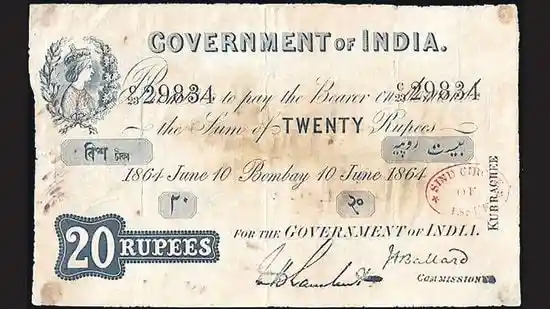Entry of paper currency
India is a diverse country. Not just in one but in many different aspects. Be it religion or population, the diversity is large in number. Not only does diversity prevail in micro aspects but it also prevails in the macro aspects, such as currency.

The first initial note that came out with a picture of Queen Victoria ; Source : Hindustan Times
The legacy of India’s currency is a long one. However, it isn’t just long, it’s largely diverse too. Starting its journey from grains being the way to buy things, going on to the barter system and landing on coin currency, the currency of India was the victim of a lot of changes.
Those changes started coming to an end with the introduction of the first kind of paper currency or perhaps notes. The paper currency was introduced with the Paper Currency Act in 1861. However, the notes were the same as they are in the present. Regardless of that being a given, when the paper currency was introduced, British Raj was still the ruling dynasty over Indian territory.
Hence, the paper which could somehow make you richer or poorer, had the image of Queen Victoria printed over them in the left upper corner in the initial stage. Before the proper currency was printed, local banks issued promissory notes which were discarded as soon as proper notes were printed.
Soon after, the Reserve Bank of India was introduced in 1935 in the country for the regulation and flow of notes and coins. The firm took over the distribution of currency in the city. The RBI also became responsible for the printing of notes whereas the government was given the responsibility of making coins.
Printing notes would probably have been fun in the beginning as there were notes of 10,000 rupees also printed without keeping track of how many were being printed. However, the first instance of demonetisation that India saw was after Independence.
Before India was hit by the wave of Independence, the notes had different designs that they were printed with. As the initial notes were printed with a picture of queen Victoria, the country even saw a George VI series of notes.
George VI was replaced by the three lion heads as a permanent symbol on the first 1 rupee note that later came out after the establishment of RBI. The same symbol was then embossed on coins as well.
Later in 1996, Mahatma Gandhi entered with his picture on the notes that gave the country a series of those imprinted notes. It has been the same since then.
India was a country where everything started with granules of grains and went on to establish paper currency as the main monetary system. The establishment of notes as currency gave a leap in a lot of systems in the country as well as in the functioning as well. Paper currency turned out to be the futuristic leap for India. However, that wasn’t the only time that the country went through such and so many changes relating to currency.

1 rupee note introduced by the RBI with the symbol of three lion heads ; Source : google.co.in


